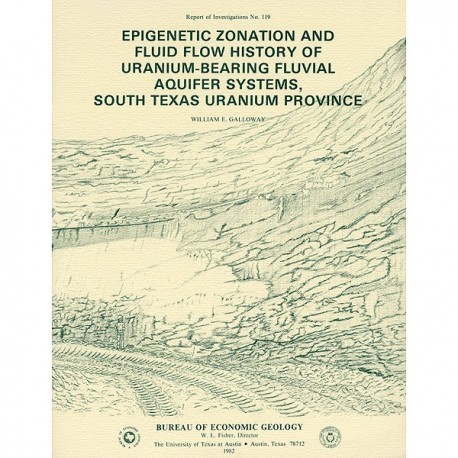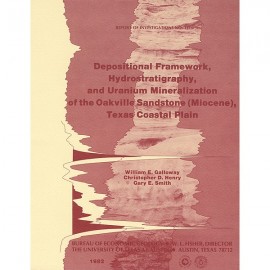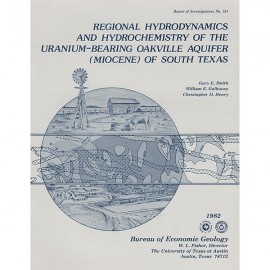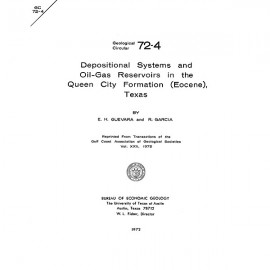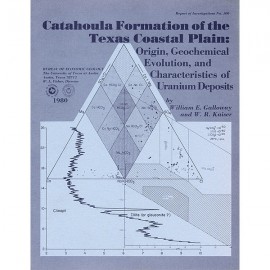Reports of Investigations
-
Books & Reports
- Reports of Investigations
- Guidebooks
- Udden Series
- Geological Circulars
- Down To Earth
- Atlases of Major Oil and Gas Reservoirs
- Texas Memorial Museum Publications
- Environmental Geologic Atlas of the Texas Coastal Zone
- Mineral Resource Circulars
- Other Reports
- Seminars and Workshops
- Handbooks
- Submerged Lands of Texas
- Symposia
- Annual Reports
- Open File Reports
-
Maps & Cross Sections
- Thematic Maps
- Miscellaneous Maps, Charts & Sections
- Geologic Atlas of Texas
- STATEMAP Project Maps
- Geologic Quadrangle Maps
- Cross Sections
- Highway Geology Map
- Energy and Mineral Resource Maps
- Shoreline Change and Other Posters
- Wilcox Group, East Texas, Geological / Hydrological Folios
- Bouguer Gravity Atlas of Texas
- River Basin Regional Studies
- Featured Maps
- Posters
- Teachers & the Public
-
Geological Society Publications
- Gulf Coast Association of Geological Societies
- Alabama Geological Society
- Austin Geological Society
- Corpus Christi Geological Society
- Houston Geological Society
- Lafayette Geological Society
- Mississippi Geological Society
- New Orleans Geological Society
- South Texas Geological Society
- GCS SEPM Publications
- Historic BEG & UT Series
Epigenetic Zonation and Fluid Flow History of Uranium-Bearing Fluvial Aquifer Systems, South Texas Uranium Province
RI0119
For a downloadable, digital version: RI0119D.
RI0119. Epigenetic Zonation and Fluid Flow History of Uranium-Bearing Fluvial Aquifer Systems, South Texas Uranium Province, by W. E. Galloway. Assisted by Constance Childs, Allen Standen, and John Suter. 31 p., 22 figs., 4 tables, 1982. ISSN: 0082335X: Print. To purchase this publication as a downloadable PDF, please order RI0119D.
ABSTRACT
The Oligocene-Miocene fluvial uranium host aquifers of the South Texas uranium province were deposited principally as syndepositionally oxidized sands and muds. Early intrusion of reactive sulfide- enriched waters produced large intrastratal islands of epigenetic sulfidic alteration, which contain isotopically heavy pyrite exhibiting unique replacement textures. The only known reservoir containing such sulfidic waters is the deeply buried Mesozoic carbonate section beneath the thick, geopressured Tertiary basin fill. Thermobaric waters were expulsed upward along major fault zones into shallow aquifers in response to a pressure head generated by compaction and dehydration in the abyssal ground-water regime. Vertical migration of gaseous hydrogen sulfide was less important. Repeated flushing of the shallow aquifers by oxidizing meteoric waters containing anomalous amounts of uranium, selenium, and molybdenum alternating with sulfidic thermobaric waters caused cyclic precipitation and oxidation of iron disulfide. Uranium deposits formed along hydrologically active oxidation interfaces separating epigenetic sulfidic and epigenetic oxidation zones. Multiple epigenetic events are recorded in imperfectly superimposed, multiple mineralization fronts, in regional and local geometric relations between different alteration zones, and in the bulk matrix geochemistry and mineralogy of alteration zones. The dynamic mineralization model described in this report may reflect processes active in many large, depositionally active basins.
Keywords: George West, Live Oak County, Ray Point, South Texas, uranium, aquifers, geochemistry, mineralization
CONTENTS
ABSTRACT
INTRODUCTION
OBJECTIVE
METHODOLOGY
AQUIFER ALTERATION
REGIONAL ALTERATION PATTERNS
DETAILED ALTERATION GEOMETRY AND ZONATION
GEOCHEMICAL AND MINERALOGICAL CHARACTERIZATION
GENERALIZED ALTERATION MODEL
COMPLEX ZONAL STRUCTURE
IMPLICATIONS FOR INTERPRETATION OF HYDROLOGIC HISTORY
HYDROGEOLOGY OF A COMPACTING BASIN
HYDROCHEMISTRY OF GROUND-WATER REGIMES
Abyssal regime fluids
Elisian regime fluids
Meteoric regime fluids
REGIME INTERACTIONS
DYNAMICS OF ORE GENESIS
MODERN FLOW DYNAMICS AND HYDROCHEMISTRY
DYNAMICS OF EPIGENETIC SULFIDIZATION
FLOW DYNAMICS OF AQUIFER METALLOGENESIS
PERSPECTIVES
ACKNOWLEDGMENTS
REFERENCES
FIGURES
1. Location of the study area and position of the underlying Lower Cretaceous shelf margin
2. Geochemical zonations produced by epigenetic oxidation and reduction of a shallow, meteoric aquifer
3. Regional alteration zonation of lower Oakville sands, Live Oak County and adjacent areas
4. Geologic framework, mineralization-front geometry, interpreted cogenetic alteration (oxidation) pattern, and direction of modern ground-water flow in George West and Ray Point districts
5. Cross-sectional geometry of mineralization fronts showing surrounding alteration zones and location of sampled core transects
6. Characteristic diagenetic features of the epigenetic sulfidic zone
7. Geochemical zonation across the Ray Point front sample transect
8. Limonite nest produced by epigenetic oxidation of iron disulfide grain
9. Diagenetic features characteristic of the resulfidized altered zone
10. Pervasive spar cement locally found in and around faulted parts of the Oakville aquifer
11. Generalized alteration zonation typical of the Oakville aquifer in the study area
12. Cross section of a complex multiple mineralization front in the George West district
13. Distribution of copper within the drilkutting sample section
14. Distribution of iron phases across the complex front
15. Distribution of calcite across the complex front.
16. Ground-water regimes in a thick, compacting basin fill
17. Tertiary basin fill of the northwestern Gulf Coast Basin
18. Typical downflow geochemical evolution of meteoric ground water
19. Plateaus of Eh characteristic of the meteoric ground-water regime of the Oakville aquifer
20. Modern ground-water flow directions and boundaries of the Oakville aquifer in Live Oak and adjacent counties
21. Water well cross section through the George West district
22. Schematic ground-water flux and alteration history characteristic of mineralized parts of the Oakville aquifer
TABLES
1. Geochemical characteristics of alteration zones sampled in George West and Ray Point districts
2. Carbon isotope composition of selected Oakville samples
3. Geochemical characterization of principal ground-water regimes of the northwestern Gulf Coast Basin
4. Volumes of sulfide and associated water required for sulfidization of the lower Oakville aquifer in the George West district and environs
Citation
Galloway, W. E., 1982, Epigenetic Zonation and Fluid Flow History of Uranium-Bearing Fluvial Aquifer Systems, South Texas Uranium Province: The University of Texas at Austin, Bureau of Economic Geology, Report of Investigations No. 119, 31 p.
